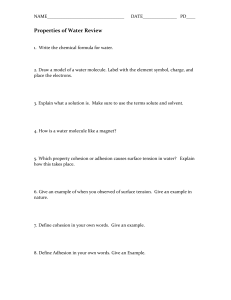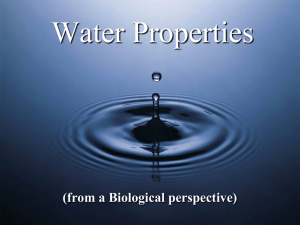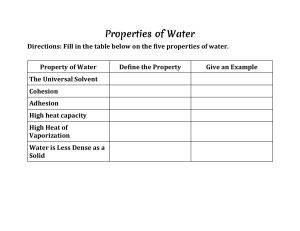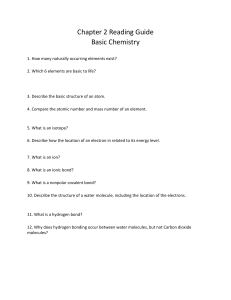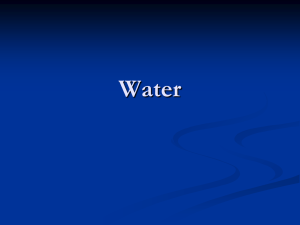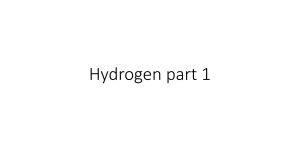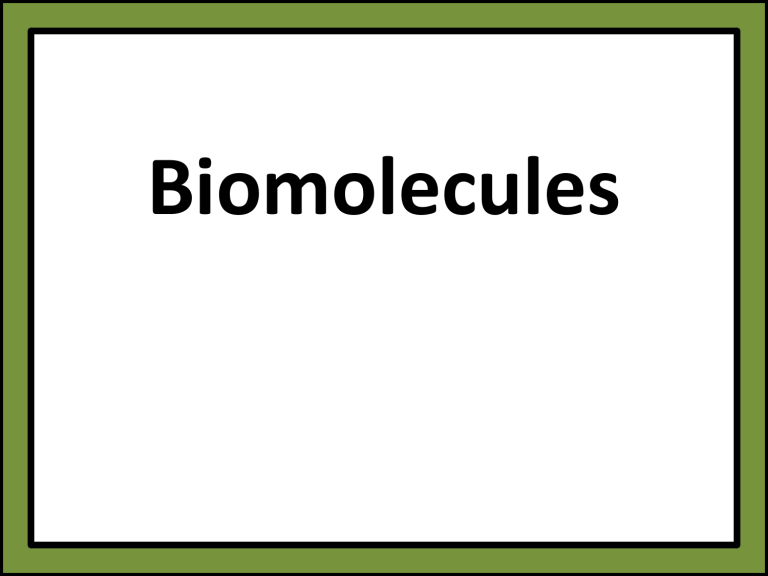
Biomolecules Biomolecules Mineral salts Inorganic water Gases Biomolecules Carbohydrates Organic Lipids Proteins Nucleic Acids Structure & Properties of Water STRUCTURE OF WATER O The bond that forms water is a covalent bond + + H H O - POLAR MOLECULE H O H The positive hydrogen ends of 1 molecule are attracted to the negative end of the oxygen of another molecule. Hydrogen bonding • Polar water creates molecular attractions – attraction between positive H in one H2O molecule to negative O in another H2O • Weak bond creates a sticky molecule H H O Elixir of Life • Special properties of water 1.cohesion & adhesion • surface tension, capillary action 2.good solvent • many molecules dissolve in H2O • hydrophilic vs. hydrophobic 3.lower density as a solid • ice floats! 4.high specific heat capacity • water stores heat 5.high heat of vaporization • heats & cools slowly Ice! I could use more ice! 1. Cohesion & Adhesion • Cohesion – H bonding between H2O molecules – water is “sticky” • Adhesion – H bonding between H2O & other substances • meniscus • water climbs up paper towel or cloth Try that with flour… or sugar… Cohesion or adhesion? How does H2O get to top of trees? Transpiration is built on cohesion & adhesion Let’s go to the videotape! CAPILLARY ACTION • The combined force of attraction among water molecules and with the molecules of the surrounding material. • Cohesion + Adhesion UNIVERSAL SOLVENT • This is a nickname given to water. • Water dissolves LOTS of things. • Remember: SOLVENT = the thing doing the dissolving SOLUTE = the thing that dissolves away • Other polar molecules can be dissolved by water. 2. Water is the solvent of life • Polarity makes H2O a good solvent – polar H2O molecules surround + & – ions – solvents dissolve solutes creating solutions Solvation Solvation is the process in which molecules of a solvent attract the particles of a solute. Solvation As ions dissolve in a solvent, they spread out and become surrounded by solvent molecules. What dissolves in water? • Hydrophilic – substances have attraction to H2O – polar or non-polar? What doesn’t dissolve in water? • Hydrophobic – substances that don’t have an attraction to H2O – polar or non-polar? fat (triglycerol) Oh, look hydrocarbons! Density of Water • Most dense at 4oC • Contracts until 4oC • Expands from 4oC to 0oC The density of water: 1. Prevents water from freezing from the bottom up. 2. Ice forms on the surface first—the freezing of the water releases heat to the water below creating insulation. 3. Makes transition between season less abrupt. Ice floats LIQUID WATER ICE LIQUID WATER ICE Why is “ice floating” important? • Oceans & lakes don’t freeze solid – surface ice insulates water below • allowing life to survive the winter – if ice sank… • ponds, lakes & even oceans would freeze solid • in summer, only upper few inches would thaw – seasonal turnover of lakes • sinking cold H2O cycles nutrients in autumn WATER = 24°C BEACH = 90°C 4. Specific heat capacity • H2O resists changes in temperature – high specific heat – takes a lot to heat it up – takes a lot to cool it down • H2O moderates temperatures on Earth High Specific Heat Capacity • Amount of heat needed to raise or lower 1g of a substance 1° C. • Water resists temperature change, both for heating and cooling. • Water can absorb or release large amounts of heat energy with little change in actual temperature. Evaporative cooling 5. Heat of vaporization Organisms rely on heat of vaporization to remove body heat High Heat of Vaporization • Amount of energy to convert 1g or a substance from a liquid to a gas • In order for water to evaporate, hydrogen bonds must be broken. • As water evaporates, it removes a lot of heat with it. Quick Qs Question 1. Circle the letter of each sentence that is true about water's specific heat. a. It is due to the many attractions among water molecules. b. It makes large bodies of water heat up more quickly than nearby land. c. It makes large bodies of water cool off more slowly than nearby land. d. It leads to warmer air over land than over water on summer days. Question2. Match the terms review. 1. Cohesion ____ 2. capillary action ____ 3. adhesion _____4. polarity _____ 5. hydrogen bond _____6. surface tension ______ 7. specific heat a. tendency to stick to other substances b. tightness caused by the pulling of water molecules on each other c. the amount of heat needed to raise 1kg of a substance 1o d. weak bonds formed between water molecules e. tendency to stick to other water molecules f. uneven distribution of charges in a molecule g. tendency to climb up due to cohesion and adhesion properties of water Property of water Ice is less dense than water Significance for life Answers The high surface tension of water means that it can form a habitat on the surface of the water High surface tension Can be used for cooling organisms by evaporation of for example sweat Strong cohesive properties and high tensile strength Colourless with a high transmission Liquid at room temperature In order to evaporate it must absorb a large amount of energy (high latent heat of vaporisation) Water can absorb a lot of energy for only a small rise in temperature (high specific heat capacity) Ice forms an insulating layer over water Conditions are stable in cells and aquatic environments Can be used for transport and a medium for reactions Light can pass through cells for photosynthesis Water can be pulled through plants in a column as the water molecules are held together by H-bonds Property of water Significance for life Ice is less dense than water Ice forms an insulating layer over water High surface tension The high surface tension of water means that it can form a habitat on the surface of the water Strong cohesive properties and high tensile strength Colourless with a high transmission Liquid at room temperature Water can be pulled through plants in a column as the water molecules are held together by H-bonds Light can pass through cells for photosynthesis Can be used for transport and a medium for reactions In order to evaporate it must absorb a large amount of energy (high latent heat of vaporisation) Can be used for cooling organisms by evaporation of for example sweat Water can absorb a lot of energy for only a small rise in temperature (high specific heat capacity) Conditions are stable in cells and aquatic environments Next To do What’s happening here? When water dissociates, one of the hydrogen nuclei leaves its electron behind with the oxygen atom to become a hydrogen ion, while the oxygen and other hydrogen atoms become a hydroxide ion. • The hydrogen ion attaches to the oxygen atom of a second un-ionized water molecule to form a hydronium ion (H3O +) The overall dissociation of water Degree of Dissociation • The degree of dissociation of a substance is defined as the fraction of its molecules dissociating at a given time • For every 10000000 molecules of water only one is ionised. • ie. Concentration of H+ in water is 1x10-7/l • Leads to large and rapid pH changes Ions: Acids & Bases An acid is any ionic compound that releases hydrogen _____ (H+) in solution. A base is any ionic compound that releases hydroxide _____ (-OH) in solution. From the Virtual Cell Biology Classroom on ScienceProfOnline.com 48 Q1: An acid is a compound that in aqueous solution will readily: A. Shed a proton. B. Shed an electron. C. Gain a proton. D. Gain an electron. E. None of the above. 49 Acidity can be measured on a scale called pH Measurements of Acidity & Alkalinity (pH) Acidity of a solution > measured by concentration of hydrogen ions (H+). pH ranges: 0 basic). (very acidic) to 14 (very Change in just one unit of scale = tenfold change in H+ concentration. If concentration of H+ = OH - … neutral. Images: pH scale, Edward Stevens, Wiki From the Virtual Cell Biology Classroom on ScienceProfOnline.com What’s the difference? 52 Weak acids • Weak acids have only a modest tendency to shed their protons (definition of an acid). • When they do, the corresponding negatively charged anion becomes a willing proton acceptor, and is called the conjugate base. 53 Weak acid Conjugate base conjugate acid the substance that results when a base gains (or accepts) a proton conjugate base the substance that results when an acid loses (or donates) a proton 54 55 Conjugate base Conjugate acid 56 Conjugate base Conjugate base 57 Why am I talking about weak acids? 58 When running really hard—let’s look at some of the effects: • blow gently through the straw into the pink solution for 15-30 seconds. • What happens? • What does the “indicator” tell you? • Why did it happen? 59 RESULTS • The solution went from pink to clear, • indicating a decrease in pH (the colorchanging dye is phenolphthalein), • i.e., an increase of acidity. What could this be due to? 60 The Hydration of Carbon Dioxide in Water CO2 + H2O H2CO3 ⇌ HCO3- + H+ As carbon dioxide goes into solution, carbonic acid is formed, which partially dissociates, liberating protons (H+) and thus causing the solution to become more acidic, i.e., lowering the pH. 61 CO2 + H2O H2CO3 What if you could reverse this… by removing carbon dioxide? HCO3- + H+ As carbon dioxide leaves the solution, carbonic acid is used up, which by the Law of Mass Action shifts the equilibrium to the left, using up protons (H+) and thus causing the solution to become less acidic, i.e., raising the pH. 62 How Does This Work? CO2 + H2O H2CO3 ⇌ HCO3 + H+ Excess bicarbonate will soak up many of the free protons, and drive the equilibrium to the left. This will reduce the acidity, increasing the pH, and the carbon dioxide produced will be blown off in the lungs. 63 64 Carbonic acid-bicarbonate buffer 65 BUFFERS Contain a weak acid and it’s conjugate base Solutions that maintain pH constant when small amounts of acid or base are added. Phosphate buffer dihydrogen phosphate Ion monohydrogen phosphate ion Add acid H+
